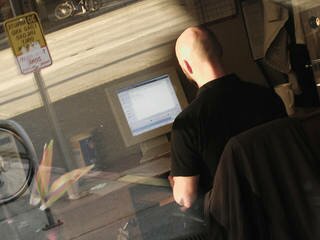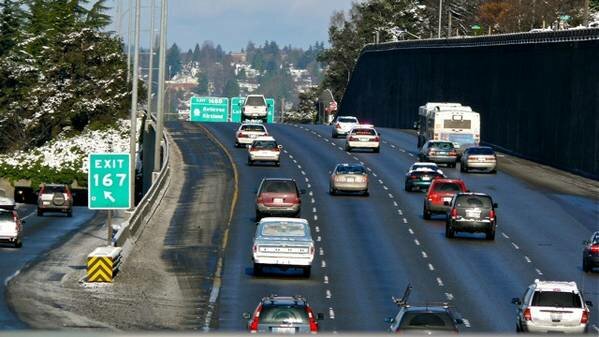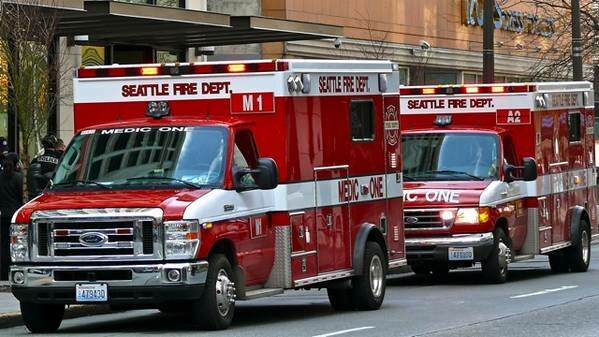Is it just me, or did that feel like a balmy 90 degrees yesterday? Cliff Mass calls this the "perfect heatwave"--lasting just long enough to warm things up, but not so long that your house begins to cook you. (A cooling-to-70s trend arrives for the weekend.) Today we're expected to beat 90 degrees, so a little forewarning is in order.
For you, courtesy of the King County Red Cross:
- Dress for the heat. Wear lightweight, light-colored clothing (light colors reflect away some of the sun's energy) and plenty of sunscreen. Wear a hat or use an umbrella to help shield you from the sun.
- Carry water or juice and drink frequently, even if you do not feel thirsty. Avoid alcohol and caffeine, which dehydrate the body. Make sure to check on youth and elderly to make sure they have enough fluids.
- Eat small meals and eat more often. Avoid foods that are high in protein, which increases metabolic heat.
- Avoid using salt tablets unless directed by a physician.
- Avoid strenuous activity. If you must do something physically demanding, try to do it during the coolest part of the day, which is usually between 4:00 and 7:00 a.m. Take regular breaks to cool off.
- Stay indoors as much as possible.
- Be vigilant about water safety if headed to a pool or beach. Never leave a child unattended near water and keep lifesaving gear handy.
- Watch for signs of life-threatening heat stroke. The person's temperature control system, which produces sweating to cool the body, stops working. The body temperature can rise so high that brain damage and death may result if the body is not cooled quickly.
- Signals of heat stroke include hot, red, and usually dry skin, changes in consciousness, rapid, weak pulse and rapid, shallow breathing.
- If you or someone you know experience symptoms, call 9-1-1 or your local EMS number. Move the person to a cooler place. Quickly cool the body by wrapping wet sheets around the body and fan it. If you have ice packs or cold packs, place them on each of the victim's wrists and ankles, in the armpits and on the neck to cool the large blood vessels. Watch for signals of breathing problems and make sure the airway is clear. Keep the person lying down.
For your pets, courtesy of PETA:...
 Sure you have a firewall, but what about people photographing you through the window? Thanks to Flickr pool member mangpages!
Sure you have a firewall, but what about people photographing you through the window? Thanks to Flickr pool member mangpages!
It's like the Los Angeles Times only cares about Seattle if we're jumping off bridges or exposing ourselves to cybercrime. The story now is one of those virally successful PR efforts, based on computer crime busters Symantec rating 50 U.S. cities "using 24-million security sensors that monitor malicious-attack activity around the globe."
They counted up PC attacks, viruses and worms, and bot-infected computers used to send spam or transmit malware, checked the frequency of the attacks, and weighed behavior like connecting to public Wi-Fi shopping online without a secure connection.
Says Symantec, Seattle is top of the charts on almost every risk factor. But let's take this with a grain of salt. I asked Mark Rushing, systems analyst and open-source pusher at Orbis Lumen, for his take. Mark would have wanted to confirm that we're talking about actually illegal acts, rather than the sexy, all-purpose "cybercrime," and to know more about the role of false positives in "attacks" reported by virus software. But here are his initial responses.
So, cybercrime mecca Seattle: hooey or not hooey?
Probably a little of both. It's marketing. You're supposed to be scared and buy Norton/Symantec products. I notice that Fox News seems to have taken the largest interest in this story.
Is security even possible any more?
Complete security has never been, and will never be, possible. You can only take precautions. The more precautions you take, the more inconvenient and impractical your experiences can become. And interestingly, the more privacy you seem give up.
What are some basic precautions people just don't "get around to"?
The best protection is increasing your awareness. If you want to be safer, you must be aware of your environment. Learning is the best thing you can do. Alas, people prefer packaged conveniences, it seems, so they buy Norton/Symantec products, or buy AVG products (or use their free one). But this lets them observe all you and your computer is doing.
Better to use an operating system that is based upon best practices in the underlying science and technology, rather than predominantly marketing forces. Your conveniences always come at a cost, and those conveniences are rarely the best (and often not even the simplest) way to do things.
And of course, don't use the same password for every site. Use unique, harder passwords for sites with access to your bank accounts. Don't install software from places you do not know or trust. Etc., etc....
February 28, 2001, at 10:54 a.m., a 6.8 "intraslab" earthquake shook the Puget Sound region for about 45 seconds. The Nisqually quake's focus was some 32 miles deep, in the Cascadia subduction zone. It might seem like things have been quiet since then, but as the graphic from the Pacific Northwest Seismic Network illustrates, we live with minor quakes almost daily.
It's the effects of major earthquakes that are on everyone's mind recently, though. Andrew Rivkin, writing for the New York Times' Dot Earth, emphasizes that the news from Chile should spur preparations in the Northwest. "The Pacific 'ring of fire' doesn't stop at the equator," he writes. In this or the next generation, the Northwest will likely experience a megathrust quake similar to Chile's, which tend to generate tsunamis.
We tend to consider the averages of megathrust quakes over the centuries as their periodicity, but Chile's last megathrust quake was only 50 years ago.
As much as we talk about the "Big One" on the way, there are still troubling lapses. King County's emergency preparedness page specifically mentions bioterrorism, floods, and flu...not earthquakes.
The Seattle Channel has earthquake safety videos, and the city offers ongoing training programs, but when you search on "earthquake kit," the first page with the elements of a disaster kit was last updated in 1999. The pdf on "How to Prepare for Earthquakes" has a total of four bullet points on things you can do beforehand, including one sentence about keeping supplies in the home. Another piece of advice is to stop driving in an earthquake.
Here's SFGate's extensive earthquake kit suggestions. Trust the Californians. UPDATE: Or, trust the Red Cross.
Something interesting happens in a number of stories about Seattle's downtown safety crisis yesterday. See if you can spot it in this KOMO story, "Downtown street crime scaring away visitors":
A survey by the Downtown Seattle Association found that panhandling is a concern among 66 percent of those polled, while open-air drug sales are a concern to 75 percent. Nearly 40 percent said they simply do not feel safe downtown.
And statistics show their fears are not misplaced. Police records show a 22 percent increase in major crimes in downtown and South Lake Union from 2008 to 2009.
See how concerns about panhandling and open-air drug sales are pretty much the same thing? And note that to KOMO reporter Melody Mendez these "fears are not misplaced": major crimes have gone up. So panhandling (not specified as aggressive) is lumped in there with homicide, rape, robbery, aggravated assault, burglary, larceny, and vehicle theft.
Or, here, in this Seattle Times story on a packed forum on public safety:
Burgess said felony crimes increased 22 percent in 2009 over the previous year from the South Lake Union neighborhood to Pioneer Square, according to Seattle Police Department crime data. Much of that increase is the result of robberies and thefts "in our downtown core," he said.
Burgess, who is championing a new initiative to crack down on aggressive panhandlers...
It happened again! Panhandling keeps sneaking in there, along with major crimes.
It's not that Downtown doesn't have a crime and safety problem. It certainly does. If I were asked if I felt safe late at night in Downtown, I'd say no, and given a chance to specify the area, certainly not. If I'm catching the bus after a show, I don't wait anywhere near Third Avenue....
One day in seventh grade, I was waiting for the #14 bus across from Washington Middle School when three teenage gang members approached this kid in my class. One gang member, who was wearing brass knuckles, suddenly punched the kid in the temple, knocking him cold.
A few teachers came out to check on the kid, who soon came to and staggered down the alley leading to Odessa Brown Childrens' Clinic, vowing revenge. No Metro security guards were there. No hidden cameras caught the scene. And so KING-5 didn't cover it. The Seattle Times was likewise silent.
Which is why you haven't heard about that beating until now, unlike that of a teenage girl in the bus tunnel, which occurred in the presence of Metro security people who did nothing to stop it, and a surveillance camera which caught the whole episode on tape. That sickening beating has sparked a fresh round of city-wide Metro-targeted outrage.
But consider this--if Metro hadn't deployed security to the bus tunnel, would a fight between teenagers even be a story? If Metro didn't have video surveillance, would the TV news be reporting it? The bad publicity Metro's getting stems from the agency's attempt to do the right thing....
 Go on. Guess how many are on cellphones.
Go on. Guess how many are on cellphones.
SB 6345--the Senate bill that would make (non-handsfree) cell phone use while driving a $124 ticket and a primary offense--was placed on second reading by the Rules Committee yesterday. (I have no idea what that means, outside of a sense of progress. There's no lyric about "second reading by Rules Committee" in Schoolhouse Rock's "How a Bill Becomes a Law.") With eleven senators sponsoring, it may have enough momentum to pass.
Its House counterpart, HB 2365, had a public hearing by the House transportation committee on the 18th, with no doings reported since then.
But the Highway Loss Data Institute--an insurer-funded nonprofit organization--has just released a study showing that anti-cell phone laws have had no effect on the number of collisions. As KING TV reports, the study compares "insurance claims for crash damage in four jurisdictions before and after bans were enacted in California, New York, Connecticut, and Washington, DC."...
Yesterday alone, if you were reading Seattle's neighborhood blogs, you would have run across Queen Anne's burglaries and break-ins; Beacon Hill Blog's stolen cars, burglaries, and sketchy behavior; and West Seattle's three break-ins. PhinneyWood was feeling exercised about graffiti, but they also reported on the armed robbery at a Ballard Walgreens.
At least anecdotally, it doesn't look like that 22 percent increase in violent crime the first six months of 2009 has subsided. The rise was really led by assaults and robberies, with a smaller increase in property crimes (burglary and other theft). The news of workaday burglaries and break-ins continues unabated, with occasional stand-outs, like clock thievery, drawing attention.
Seattle Crime's Jonah Spangenthal-Lee, taking the long view, argues that if Seattle really did just enjoy a 40-year low in crime rates, a regression to the mean doesn't indicate anyone or thing is to blame. But his "Morning Blotter" post begins: "Burglars will steal ANYTHING," and yesterday's blotter contained a story about a man who claims a gang threatened to shoot him if he didn't rob a store in Northgate. So once again, statistics provide cold comfort.
The Seattle Times op-ed pages also contain a "parsing the crime stats" piece with "sobering reality checks." I'm not sure that I agree with the "parsing" that leads to this statement: "Nationwide, violent crime and property crimes have decreased. So what explains Seattle's uptick? One answer readily given by criminologists is that crime tends to rise during tough economic times." (That would not explain Seattle's uptick, would it? I can't think the Times editorial board means to argue that Seattle alone is experiencing tough economic times.)...
What do we want? Bus and library hours! When do we want 'em? Over the next biennium!
Bus service hours for the next two years won't be cut, says the King County Council. Instead, fares will go up $0.25 each year, to $2.00/$2.25 (off-peak/peak one-zone fare) in 2010 and $2.25/$2.50 in 2011.
That, combined with full bus-wrap ads (with an open strip for windows), more efficient bus routes and scheduling, and diverted funding from the King County Ferry District, will save the 310,000-odd hours that had been on the table.
Those are generic bus hours, of course--Metro is not making any promises about your particular bus route not changing. In fact, the budget crunch (Metro had been looking at a $213 million deficit for the next two years under the proposed budget) gives Metro license to use software to optimize its routes and schedules more aggressively--something I believe they have wanted to do for some time, but have held off on due to the "You moved my cheese!" response of riders outraged at things changing.
Seattle Transit Blog notes that, in other transit news, the federal government is considering letting the FTA take over safety regulation of "commuter rail, subway, and light rail systems nationwide," citing "increased collision rates, derailment rates, and worker fatalities." Federal oversight would eventually extend to bus transit systems, too. Depending on the administration, this could be either good news--federal money for safety--or bad news, if safety regulations are tightened to make transit costs prohibitive.


Most Recent Comments